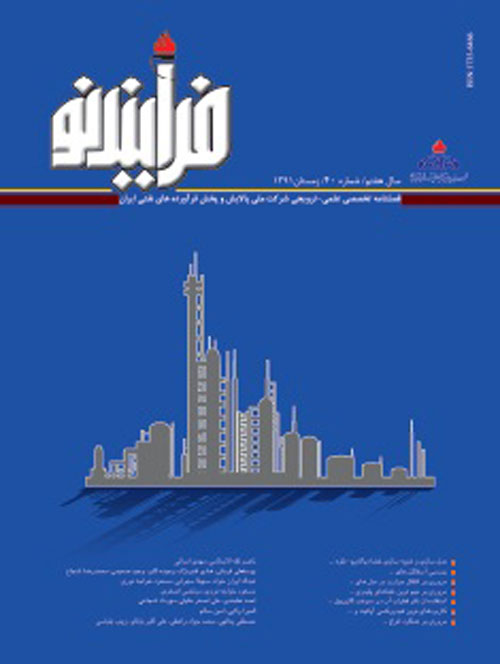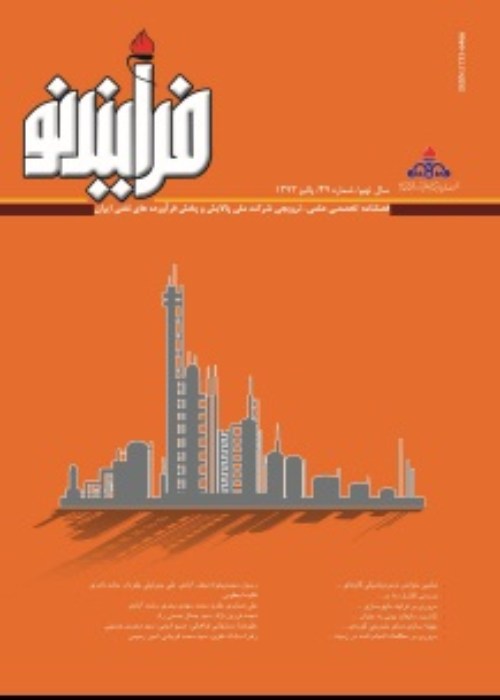فهرست مطالب

مجله فرآیند نو
پیاپی 52 (زمستان 1394)
- تاریخ انتشار: 1394/11/15
- تعداد عناوین: 6
-
- علمی ترویجی
-
صفحات 5-20مفهوم غشاهای شبکه آمیخته؛ یعنی ترکیبی از ذرات جامد پخش شده درون ماتریس پلیمر؛ راهکاری موثر برای افزایش کارایی غشاهای پلیمری در جداسازی گاز است. در این دیدگاه، با ترکیب خواص مناسب نانوذرات معدنی با خواص فاز آلی پلیمر، میتوان به یک غشاء جداسازی گاز با تراوایی و گزینش پذیری بالا، مقاومت مکانیکی و شیمیایی خوب و فرآیندپذیری مناسب دست یافت. در این مقاله مروری، به عوامل موثر بر کارایی غشاهای شبکه آمیخته در جداسازی گاز، انواع غشاهای شبکه آمیخته از لحاظ ساختار و روش تشخیص آن، انواع روش های ساخت این غشاها، همچنین انواع نانوذرات معدنی متداول در ساخت غشاهای شبکه آمیخته و نحوه تاثیر هرکدام بر عملکرد غشاء، انواع مورفولوژی فصل مشترک پلیمر/ ذره، مکانیسم های انتقال گاز درون غشاهای شبکه آمیخته، مهمترین مدلهای پیش بینی کننده عملکرد آن ها و در نهایت خط مشی آینده این دسته از غشاها پرداخته و درباره آنها بحث شده است.کلیدواژگان: غشاء شبکه آمیخته، جداسازی گاز، فصل مشترک پلیمر، ذره، پرکن، مدلهای تراوایی
-
صفحات 21-36در این تحقیق سیستم تعادلی پایپرزین-آب- دی اکسیدکربن با استفاده از مدل های شبکه عصبی مدل سازی شده است. در مدل از دو شبکه عصبی MLP، RBF استفاده شده است. در یادگیری شبکه ها الگوریتم پس انتشار خطا به کار رفته است. برای آموزش و تست شبکه های عصبی یک مرور کلی بر کارهای تجربی در زمینه حلالیت دی اکسیدکربن در محلول آبی پایپرزین انجام شده و داده های تجربی جمع آوری و طبقه بندی شده است. نتایج شبکه های عصبی با داده های تجربی ارائه شده در مقالات مورد ارزیابی قرار گرفت. متوسط مربع خطاهای کل داده ها برای شبکه MLP برابر با 21/4 درصد و برای شبکه RBF برابر با 78/4 بوده که نشان از پیش بینی مناسب شبکه های مورد استفاده می باشد. نتایج نشان داد که شبکه های عصبی ابزاری مناسب بر کاهش زمان محاسبات و افزایش دقت پیش بینی داده های تعادلی می باشند.کلیدواژگان: مدل سازی، داده های تعادلی، پایپرزین، دی اکسیدکربن، شبکه های عصبی
-
صفحات 37-51فرآیند جذب سطحی توسط کربن فعال از متداول ترین فرآیندهای حذف فلزات سنگین از پساب های مختلف می باشد. در این مطالعه، مدل سازی فرآیند جذب یون های فلزی Pb2+، Cd2+ و Ni2+ توسط کربن فعال در حالت های تعادلی و سینتیکی بررسی شده است. ایزوترم های لانگمیر، فرندلیچ، ردلیش-پترسون و سیپس برای مطالعه سیستم تعادلی جذب در حالت تک جزئی و ایزوترم لانگمیر چند جزئی برای بررسی تعادل در سیستم های جذب چندجزئی استفاده شدند. ایزوترم های کاربردی پیش بینی خوبی از تعادل سیستم داشتند. مدل های شبه مرتبه اول، شبه مرتبه دوم و نفوذی برای مطالعه سینتیک سیستم به کار رفتند. بر اساس نتایج، مدل نفوذی همراه با ایزوترم لانگمیر کمترین خطا را بین مدل های مختلف دارد. مقدار ضریب نفوذ موثر هر یون فلزی در سیستم های جذب به ترتیب برای یون های فلزی Pb2+، Cd2+ و Ni2+ مقادیر cm2.s-1 6-1092/1، cm2.s-1 6-109/1و cm2.s-1 6-102/1 محاسبه شد.کلیدواژگان: یون های فلزی، کربن فعال، ایزوترم، سینتیک، مدل نفوذی
-
صفحات 52-77پساب های روغنی در صنایعی همچون نفت، پتروشیمی و غذایی تولید می گردند. این پساب ها عمدتا به شکل امولسیون های روغن/ آب می باشند. جداسازی روغن نیاز به درک خواص فیزیکی و شیمیایی امولسیون های روغن/ آب دارد. به منظور انتخاب فرآیند جداسازی مناسب، باید خواص متعددی که نقش کلیدی در پایداری امولسیون های روغن/ آب دارند را اندازه گیری نمود، که از جمله آن ها می توان به کشش سطحی، زاویه تماس، پتانسیل زتا و توزیع اندازه قطرات اشاره نمود. تصفیه پساب های روغنی توسط روش های مختلفی صورت می گیرد و میزان جداسازی بستگی به غلظت و طبیعت فیزیکی روغن و توزیع اندازه ذرات و همچنین روش مورد استفاده دارد. هدف از این مقاله، مطالعه مشخصات و خواص سیستم روغن/آب و روش های جداسازی روغن از پساب های صنعتی می باشد. این روش ها شامل، جداسازی با نیروی گرانش و سانتریفیوژ، تصفیه شیمیایی، شناورسازی، فرآیندهای غشایی، تبخیر، جذب با کربن فعال و تصفیه بیولوژیکی می باشد. در پایان هزینه های تصفیه و روش های هیبرید غشایی مورد بررسی قرار می گیرد.کلیدواژگان: امولسیون روغن، آب، تصفیه پساب های روغنی، فرآیندهای غشایی
-
صفحات 78-89روش های متعددی جهت جداسازی دی اکسید کربن از خروجی کارخانه های مختلف ارائه شده ، لیکن این روش ها نمی توانند برای پایین آوردن میزان دی اکسید کربن موجود استفاده شوند. برای نیل بدین منظور جداسازی مستقیم دی اکسید کربن از هوا، به کار گرفته می شود. در این تحقیق، شبیه سازی فرآیند توسط نرم افزار صورت گرفته و پارامترهای مختلف موثر بر میزان بازیابی دی اکسید کربن و مصرف انرژی، برای دستیابی به بالاترین میزان بازیابی دی اکسید کربن و کمترین مصرف انرژی بررسی می شوند. بررسی ها نشان می دهد عواملی چون نوع و میزان حلال مصرفی و شدت جریان حلال در کاهش مصرف انرژی در فرآیند جداسازی مستقیم دی اکسید کربن از هوا موثر می باشند. متوسط میزان بازیابی با شرایط در نظر گرفته شده حدود 89 درصد و متوسط انرژی مصرفی نیز حدود 8 گیگاژول به ازای هر تن دی اکسید کربن بازیافتی محاسبه شده است.کلیدواژگان: دی اکسید کربن، جداسازی مستقیم از هوا، شبیه سازی، جذب
-
صفحات 90-99غشاهای تبادل کاتیونی ناهمگن بر پایه پلی وینیل کلراید با استفاده از تکنیک قالب گیری محلول پلیمری تهیه گردید. اثر وجود نانو لوله های کربن عامل دار و نیز نانو ذرات ترکیبی نانو لوله کربن- نانو لایه نقره، بر خواص الکتروشیمیایی و ضد باکتریایی آنها بررسی شد. نانو ذرات ترکیبی با استفاده از تکنولوژی کندوپاش مگنترون در محیط پلاسما تهیه گردید. تصاویر میکروسکوپ نوری، پراکندگی یکنواخت نانو ذرات را در بدنه غشاهای پلیمری نشان می دهد. همچنین پوشش سطح نانو لوله های کربن به کمک نانو لایه های نقره سبب توزیع یکنواخت تر نانو ذرات در ساختار غشاها گشته است. نتایج نشان می دهد که خواص الکتروشیمیایی غشاها، با استفاده از نانو ذرات بهبود می یابد. همچنین غشای تهیه شده بوسیله نانو ذرات ترکیبی نانو لوله کربن- نانو لایه نقره، عملکرد الکتروشیمیایی و خاصیت ضد باکتریایی مناسب تری جهت حذف باکتری E-Coli در مقایسه با سایر غشاهای تهیه شده دارد.کلیدواژگان: غشای تبادل یون، نانو ذرات ترکیبی، کندوپاش مگنترون، پلاسما، خواص الکتروشیمیایی و عملکرد ضد باکتریایی
-
Pages 5-20The concept of mixed matrix membranes (MMMs) comprising rigid particles dispersed in a continuous polymeric matrix was proposed to improve the separation properties of polymeric membranes. In this approach, the good advantages of both polymeric matrix and inorganic fillers combined and a good permeable membrane with high selectivity, chemical stability, mechanical strength and processability can be prepared. In this article, factors affecting the performance of MMMs where reviewed. Also, the types of MMMs by structure, preparations methods were discussed. In addition, types of common inorganic fillers, gas transport mechanism in MMMs, stress and defects in polymer/inorganic interface and the most prevalent models which can predict the performance of MMMs were stated and discussed. Finally, the future directions of researches in this context and potential usages of MMMs where shown.Keywords: Mixed matrix membrane, Gas separation, Polymer, particle interface, Filler, Permeation models
-
Pages 21-36In this study, equilibrium system of H2O-Pz-CO2 has been modeled using neural networks. In the modeling two networks RBF and MLP were used. Back propagation algorism was used in the learning of the networks. In the RBF network, nonlinear Gaussian function was used as an activation function whereas sigmoid function was used in MLP network. The networks results were evaluated by experimental data presented in the literature. Mean absolute error for RBF and MLP are 4.21 and 4.78 percent, respectively. The results showed that neural networks are suitable tools for decreasing of calculation time and increasing of accuracy in the equilibrium data predictions.Keywords: Modeling, Equilibrium data, Piperazine, Carbon dioxide, Neural Network
-
Pages 37-51Adsorption process with activated carbon is one of the most common methods for heavy metals removal from various wastewaters. In this study, modeling of of Pb2,Cd2,Ni2 adsorption have been investigated with activated carbon in equilibrium and kinetic states. Langmuir, Freundlich, Redlich-Peterson and Sips isotherms were applied for study of equilibrium in single adsorption systems and multicomponent Langmuir isotherm was selected for equilibrium study in multicomponent adsorption system. All studied isotherms had good prediction for equilibrium of these systems. Pseudo-first order, pseudo second order and film-pore volume diffusion model were applied for investigation of adsorptionkinetics. According to the results, film-pore volume diffusion model based Langmuir isotherm had minimum average relative error. Effective pore volume diffusivity was determined 1.9210-6 cm2.s-1, 1.9010-6 cm2.s-1 and 1.2010-6 cm2.s-1, for Pb2, Cd2 and Ni2, respectively.Keywords: metal ions, Activated carbon, Isotherm, kinetic, diffusional model
-
Pages 52-77Oily wastewaters are generated in many industrial processes, such as petroleum refining, ýpetrochemical and food. These oily wastewaters are mainly in the form of oil-in-water (O/W) ýemulsions. Oil removal requires an understanding of the physical properties and chemical ýcomposition of O/W emulsions. Several properties in the stability of an O/W emulsion should ýbe measured for the selection of the appropriate separation process, specifically, surface ýtension, contact angle, zeta potential and droplet size distribution. Treatment of oily ýwastewaters is performed by a variety of methods and the degree of oil removal depends on ýthe concentration and physical nature of the oil, droplet size and separation techniques. The ýpurpose of this work is to study oil/water system properties, and techniques for removing oil. ýThese techniques include gravity and centrifugal separations, chemical treatment, flotation, ýmembrane processes, evaporation, activated carbon adsorption and biological treatment. At ýlast, treatment costs and hybrid processes will be covered.ýKeywords: O, W emulsion, Oily wastewaters treatments, Membrane separation
-
Pages 78-89Several methods have been presented for CO2 capture from the flare of the factories, but these methods are not able to lower the existing atmospheric CO2. Direct air capture of CO2 has to be used for this purpose. In the current research, this process is simulated with the aid of software and the influence of different parameters such as the type and flow of the solvent, the number of the trays of the absorption and desorption towers on the energy consumption and CO2 recovery are studied. The results show that the average CO2 recovery is about 89% and the average energy consumption would be about 8 GJ for each ton of recovered CO2.Keywords: CO2, Direct Air Capture, simulation, Absorption
-
Pages 90-99Polyvinyl chloride based heterogeneous cation exchange membranes were prepared by solution casting technique. The effect of multi walled carbon nano tubes and also MWCNTs-co-Ag nanolayer composite nanoparticles on electrochemical and antibacterial properties of membranes was studied. The MWCNTs-co-Ag nanolayer composite nanoparticles were prepared by magnetron sputtering method. Scanning optical microscopy images showed uniform particles distribution for the membranes. Also surface modification of MWCNTs by Ag nanolayer caused to more uniformity for the membranes. Results showed that membrane electrochemical properties were improved by using of nanoparticles in membrane matrix. Also the modified membrane containing Multi Walled Carbon Nano Tubes-co-Ag nanolayer showed more suitable electrochemical characteristics and antibacterial property in E-Coli removal compared to others.Keywords: Ion exchange membrane, Composite nanoparticles, Magnetron sputtering method, Plasma, Fabrication, electrochemical characterization, Antibacterial property


